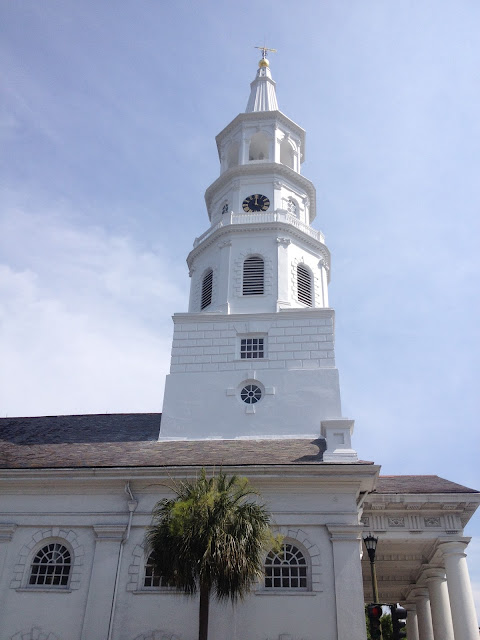After getting lost (of course) getting to the Visitor's Center, we parked and went inside to get some info. Leaving with an armload of pamphlets, we jumped on the first trolley we saw and soon found ourselves at Waterfront Park. The day was overcast but warm, so the fountain spray was welcome!
This is a beautiful and historic district of Charleston, with parks and walks along the confluence of the Ashley and Cooper Rivers. This area was devastated during the bombardment by Union forces during the Civil War, but was soon rebuilt even more spectacular than before.
The Battery, which is an area that has been fortified since the founding of Charleston, is also home to some very nice homes. Most of these remain as private residences, but they are extraordinary examples of the Charleston style, which is a fairly narrow building with long verandas on the upper floors to catch the evening breeze.
Not all of the homes are large and impressive, some are small and impressive!
This is possibly the oldest house in Charleston. Built of Black Cypress, it has been definitely dated to 1755, and records suggest it may have been built as early as 1721. The lot was granted to John Stevens in 1682!
Tucked in amongst the tall mansions are some tiny little gems that most likely were slave quarters at one point. Slaves were important to daily household operations as much as they were to field work on plantations, and were generally provided with separate living quarters somewhat distanced from the main house.
Charleston is know as Church City because of the large number of churches in town. It is also known as The Gateway City because it's port is and was a huge trade center. Back in the day, it was rice and cotton, and today it's....well, everything. Charleston is the fourth busiest port in the US and the second busiest on the East Coast.
We decided the city should be called the Crepe Myrtle City since there are hundreds of the beautiful plants in full bloom around the historic district.
Up and down the streets we walked, South Battery, King St, Meeting St., Legare and Broad Streets. Magazine, Queen and Cumberland Streets, walking with our figurative mouths hanging open at the beauty of the homes and the trees and plants. Eventually we found ourselves at the City Market. Six blocks long and 50 feet wide, the market has sellers of anything and everything. From Sweet Grass Gullah baskets to BBQ sandwiches, you can find it here!
We found an unusual round church, with a graveyard that contains stones dating back to 1695! The church is called The Circular Congregational Church and church records indicate that more than a thousand people are buried in the graveyard.
From churches by the dozen,
to the lovely houses on Rainbow Row, where soft pastels please the eye,




















No comments:
Post a Comment